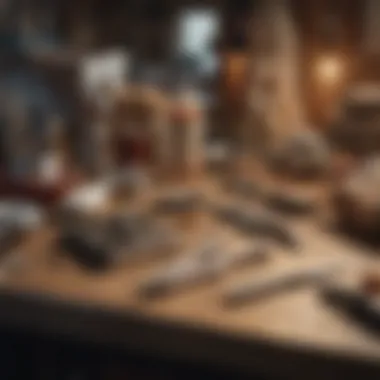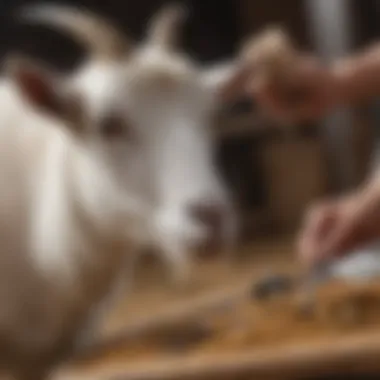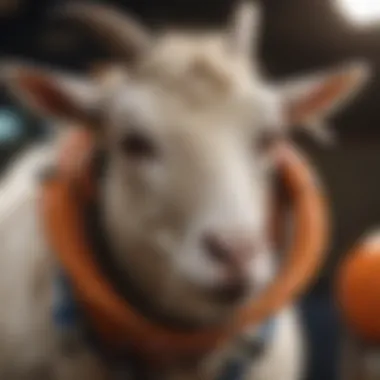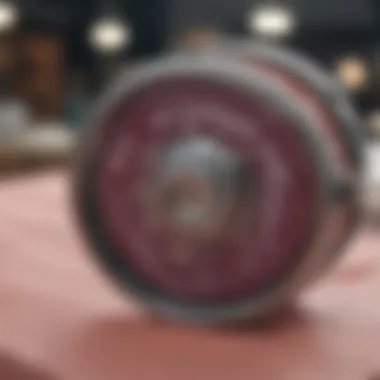Essential Castration Tools for Goats: A Comprehensive Guide


Intro
Castration of goats is a significant procedure that has implications for both animal welfare and agricultural efficiency. Understanding the essential tools and methods for this process is crucial for farmers and pet owners alike. This guide moves beyond mere descriptions to explore the tools, techniques, and safety measures necessary for humane castration. As you read further, you will develop a comprehensive insight into the world of goat castration, empowering you to make informed decisions about your livestock.
The Importance of Castration
Castration performs several roles in goat management. It can improve behavior, control breeding, and decrease health risks. Utilizing the right tools and techniques ensures the procedure is efficient and minimizes stress for the animal. The following sections will detail the necessary tools and methods to achieve these goals effectively and ethically.
Essential Castration Tools
When discussing castration tools, it is essential to recognize the variety available. Each tool serves a specific purpose within the procedure. Familiarity with these tools is vital for a smooth process.
Elastrator
The elastrator is commonly used for castration, especially in young goats. It involves placing a rubber band around the base of the scrotum, cutting off blood supply. This method is quick, but proper application is critical. The tool should be easily operable and made of durable material to withstand the pressure.
Surgical Instruments
For more mature goats, surgical methods may be appropriate. Essential surgical instruments include scalpels, forceps, and scissors. These tools demand careful handling. Surgical castration can involve more risks and requires a level of skill.
Anesthesia Equipment
Pain management is an essential aspect of any surgical procedure. This involves various delivery methods of anesthetics, such as injections or topical applications. Ensuring the right equipment is available for anesthesia can improve animal welfare significantly.
Best Practices for Castration
Preparation Steps
- Assess the Animal: Consider the age, weight, and health status.
- Choose the Right Method: Evaluate whether you will use an elastrator or surgical approach.
- Gather Necessary Tools: Have everything ready beforehand to minimize stress during the procedure.
“Effective castration practices contribute to better animal welfare and improved herd management.”
Aftercare
Following the castration, monitoring the goat is essential. Watch for signs of infection or excessive bleeding. Provide a quiet, clean space for recovery. Proper aftercare can make a significant difference in the healing process.
End
Understanding the essential tools and methods for castration can significantly affect the welfare of your goats. By prioritizing humane practices and employing the correct tools, you contribute to better livestock management. As we continue this guide, more in-depth topics will follow, enriching your understanding and enabling better practices for your goats.
Understanding Goat Castration
Castration in goats is an important practice with various implications for both livestock management and animal welfare. Understanding goat castration involves more than just the act itself; it requires insight into the underlying purpose and rationale. Without a clear comprehension of these aspects, pet owners and livestock enthusiasts may struggle to navigate the complexities of this process.
Castration serves essential functions within goat management. It ensures better behavior in male goats, help maintain a harmonious environment within herds, and plays a crucial role in breeding control. In essence, understanding the reasons for castration leads to informed decision-making that can directly impact the health and wellbeing of goats.
Purpose of Castration in Goats
The primary purpose of castration in goats is to control reproduction. Male goats, or bucks, can mate with multiple females, which could lead to overpopulation and an imbalance in herd dynamics. By castrating male goats, owners can prevent unplanned breeding, thus making herd management easier and more efficient.
Additionally, castration reduces aggressive behaviors often associated with male goats. Intact males can exhibit challenging behaviors like fighting or challenging the dominance of other goats. Removing the testicles helps reduce these instincts and fosters a calmer demeanor, creating a more stable herd environment. This behavioral change benefits both the goats and their handlers, making handling and care simpler.
Moreover, castration can improve the overall meat quality in male goats. When bucks mature, hormonal changes influence meat characteristics. Castrated goats, often referred to as wethers, produce tender and flavor-rich meat, which can enhance its marketability.
Common Reasons for Castration
Several reasons justify the practice of castration in goats. One common reason is unwanted breeding control, as mentioned earlier. When male goats are not intended for breeding, castration is a practical solution to prevent accidental breedings.
Another significant reason is behavioral management. Intact male goats may exhibit aggressive behavior, especially during mating season. Castration alleviates these aggressive tendencies, contributing to smoother interactions within the herd.
Animal welfare also plays a vital role in this decision. Owners must consider the long-term wellbeing of their goats, as castration can alleviate discomfort associated with certain behaviors and conditions.


In summary, understanding the purpose and common reasons for castration in goats is critical for effective herd management and humane animal care. By knowing why and how to carry out this procedure, owners can ensure a better quality of life for their goats while promoting responsible livestock practices.
Overview of Castration Methods
Castration is a crucial practice in the management of goats. Understanding the methods available is important for the health and welfare of the animal. Different techniques serve various purposes and have distinct implications for both the goat and the owner. This section examines the primary methods, emphasizing their benefits and considerations.
Surgical Castration
Surgical castration is a traditional method that involves the removal of the testicles through an incision. This technique is usually performed on younger goats and is often chosen for its effectiveness. The benefits of surgical castration include a higher success rate and immediate results, as it avoids complications from the techniques that rely on deterring blood supply.
In surgical procedures, proper sterilization of instruments is paramount. A scalpel, forceps, and sutures are the primary tools needed in this method. Immediate post-operative care is also vital to ensure the goat recovers well. Some factors to consider include:
- Skill Level: This method requires a competent understanding of animal anatomy.
- Anesthesia: General anesthesia is often necessary to avoid pain during the procedure.
- Aftercare: Close monitoring of the goat’s health post-surgery is essential for preventing infections or complications.
While effective, the need for skill and aftercare means that this method might not be practical for everyone.
Non-Surgical Castration Techniques
Non-surgical techniques have gained popularity due to their less invasive nature. Two prominent non-surgical methods are the Burdizzo clamp and the elastrator banding tool.
Burdizzo Clamp
The Burdizzo clamp crushes the blood vessels to the testicles, preventing blood flow. This method is less painful than surgical options and often employed when minimal intervention is desired. However, there are also some disadvantages:
- Timing: It requires precise timing to ensure success, and improper application may lead to complications.
- Experience: Users need to have experience to execute the method correctly.
Elastrator Banding Tool
The elastrator involves placing a rubber band around the base of the scrotum, leading to eventual tissue necrosis. This method is often used for young goats, as it reduces the stress of surgery and anesthesia.
Benefits of elastration include:
- Simplicity: It is easily performed by individuals without deep surgical skills.
- Cost-effectiveness: It usually involves less expense compared to surgical options or complex equipment.
This technique also requires monitoring, as proper care must be taken as the tissues die off to prevent infection and ensure comfort for the animal.
Non-surgical methods are increasingly seen as humane alternatives, balancing effectiveness with minimal stress for the goat.
Overall, each method of castration has its own set of advantages and considerations. Understanding these techniques will guide goat owners in making informed choices about the best practices for their animals. Proper selection ensures both welfare and effective management of the herd.
Essential Castration Tools
In the process of goat husbandry, the importance of using the right tools for castration cannot be overstated. Having the proper instruments ensures that the procedure is carried out effectively and humanely. The selection of tools used during goat castration directly affects the health and well-being of the animal. Utilizing the best equipment minimizes pain and promotes quicker recovery, which is essential for both the goat and the owner.
Scalpel and Surgical Instruments
Surgical instruments, particularly scalpels, play a critical role in traditional surgical castration. The scalpel is used for making incisions that facilitate the removal of testicular tissue. A sharp and sterile scalpel can significantly reduce bleeding and discomfort during the procedure. Alongside scalpels, it is crucial to have additional surgical tools such as scissors, clamps, and forceps. Each instrument contributes to a sterile, organized, and efficient process while ensuring the best outcomes for the goat’s health.
Burdizzo Clamp
The Burdizzo clamp is an essential tool for non-surgical castration methods. This tool compresses the spermatic cords, effectively cutting off blood supply to the testicles without making any incisions. As a result, the testicles shrink and eventually fall away. This method is less invasive and can be less painful, as it avoids open wounds. When using a Burdizzo clamp, accuracy in application is key to ensure maximum effectiveness. Proper training or guidance may be necessary to optimize results with this device.
Elastrator Banding Tool
The elastrator banding tool is another common instrument used in goat castration. It employs rubber bands that are placed around the base of the scrotum to restrict blood flow. Over time, the testicles die and fall off. This method is best suited for younger goats, as their small size makes them more tolerant of the process. The advantage of using the elastrator tool is that it is relatively simple and effective. However, it is crucial to monitor the goat post-procedure to ensure the absence of complications.
Anesthesia Equipment
Proper anesthesia is an important aspect of goat castration, especially with surgical methods. It is crucial to minimize the pain felt by the goat. Anesthesia equipment, including regional blocks or local anesthetic agents, should be readily available. Understanding the appropriate dosage and administration routes is critical for safety and efficiency. The welfare of the animal should always be the top priority when preparing for the procedure.
Post-Operative Care Supplies
After the castration procedure, post-operative care supplies are vital for ensuring a smooth recovery. Antiseptics, bandages, and pain relief medications should be provided to the goat. Keeping the wound clean and monitored is essential to avoid infections and complications. Regular check-ups and a suitable environment will help the goat in healing properly. Providing high-quality post-operative care is important for both animal welfare and the return to normal activity.


Selecting the Right Tools
Selecting the appropriate tools for goat castration is crucial for achieving effective and humane results. The right tools not only simplify the procedure but also minimize discomfort for the animals. It is fundamental to understand that various tools come with specific applications, and using the wrong ones can lead to increased pain or complications.
When choosing tools, several factors come into play, including the method of castration selected, the age and size of the goat, and the experience level of the individual performing the procedure. Ensuring that the tools are appropriate for the task at hand is essential. High-quality instruments can also promote greater safety and efficiency. Thus, making informed decisions in this area greatly impacts both the short- and long-term welfare of the goat.
Factors to Consider
Choosing the right castration tools requires careful consideration of several factors:
- Method of Castration: Different methods demand distinct tools. Surgical castration requires scalpels and sutures, whereas non-surgical techniques like the Burdizzo clamp require specialized equipment for blood vessel occlusion.
- Animal Size and Age: Young goats may need smaller, more delicate tools, while larger animals need sturdier options. Tools must suit the animal's specific anatomy to ensure effectiveness.
- Ease of Use: Familiarity with the tools can affect the procedure's success. An experienced individual should opt for tools with which they are comfortable to minimize risks.
- Safety Features: Choose tools that have safety mechanisms or ergonomic designs to reduce the chances of accidents during the procedure.
By weighing these factors, one is better equipped to make sound choices that prioritize the animal’s welfare.
Quality versus Cost
The dynamic between quality and cost in castration tools warrants a thorough evaluation. On one hand, high-quality instruments often come with a higher price tag. However, investing in reliable tools can prevent complications and ensure better outcomes.
Here are some considerations to keep in mind:
- Longevity: Quality tools tend to last longer and withstand repeated use. This reduces the need for regular replacements and may be cost-effective in the long run.
- Performance: Well-made tools perform better, providing smoother, cleaner cuts or band applications which are critical during castration.
- Safety: Better-quality tools often include features that enhance safety, reducing the risk of accidental injury.
Castration is a delicate process. Spending extra on quality tools can pay off, ensuring the procedure is executed properly and humanely. As such, the short-term financial investment should be viewed in the broader context of animal care and management.
Step-by-Step Castration Procedures
Castration is a crucial procedure in goat management. Understanding the intricacies of each stage helps ensure animal welfare and the overall effectiveness of the process. This section outlines the steps necessary for proper castration, highlighting the importance of preparation, execution, and follow-up. Each step merits careful attention to safeguard health and minimize trauma to the animals involved.
Preparing for the Procedure
Preparation sets the stage for a successful castration procedure. Ensuring that all tools and equipment are present and properly sanitized is essential. Here are critical steps included in the preparation phase:
- Choose a Suitable Location: Select a calm and clean area with enough space to work comfortably. Outdoor settings may be beneficial, provided the ground is even and dry.
- Gather Required Tools: Collect all needed tools like surgical instruments, anesthesia equipment, Burdizzo clamps, and elastrator bands. Keeping them within easy reach reduces stress.
- Assess the Goat's Health: Performing a health check on the goat before the procedure is vital. Observing for signs of illness can prevent complications during recovery.
- Have Backup Supplies: Make sure to have extra supplies on hand. In castration, it's not uncommon for tools to malfunction. Being prepared can avoid delays or accidents.
Performing Surgical Castration
Surgical castration is a method often chosen for its directness. It is essential to execute this step with precision. The following are steps important to carry out during the procedure:
- Administer Anesthesia: Use appropriate anesthesia, either local or general, based on the method of castration and the guidelines discussed with a veterinarian.
- Position the Goat: Secure the goat in a way that prevents movement. Straps or gentle physical restraint can be effective here. Comfort is key to minimize stress.
- Make the Incision: Use a scalpel to make a careful incision. This must be done swiftly but also cautiously to avoid unnecessary bleeding.
- Remove the Testes: Carefully excise the testes while observing for blood vessels. Control any bleeding appropriately; it's essential to avoid excessive blood loss.
- Close the Incision (Optional): In some cases, sutures may need to be placed to close the incision. This is less common for quick recovery but can be necessary depending on the method used.
Using the Burdizzo Clamp
The Burdizzo clamp is a non-surgical method that works by crushing the blood vessels leading to the testes. This technique is less invasive. Here are basic steps for using the Burdizzo clamp:
- Placement of the Clamp: Position the clamp carefully on the cord. It's crucial to ensure it is correctly placed to avoid damaging surrounding structures.
- Applying the Clamp: Firmly squeeze the handles to crush the blood vessels. It should be held in place for the recommended duration, typically around 10 to 15 seconds.
- Repeat on the Other Side: After releasing the first, move to the other cord and repeat the clamping process.
Applying Elastrator Bands
Elastrator banding is another method of castration. It involves using a tight band to cut off blood supply slowly. The procedure must follow specific steps:
- Position the Elastrator Band: Place it high on the scrotum, ensuring it’s as tight as possible yet comfortable.
- Stretch the Band: Use the elastrator tool to stretch the band, allowing it to sit over the testes completely.
- Release the Band: Release the band from the tool and check that it remains tight. This method will naturally lead to tissue death and eventual falling off of the testes.
Post-Castration Care
Post-castration care is a critical phase in the overall welfare of goats. Proper care after the procedure ensures that the animal heals effectively and does not face avoidable complications. It is not simply about monitoring the immediate aftermath; it involves a structured approach to their overall recovery. The type of supportive care administered can significantly influence the goat's health long-term.
Monitoring Health After Castration
After castration, it is essential to monitor the goat's health closely. This includes checking for behavioral changes, appetite levels, and general activity. A drop in energy or interest in food may indicate potential problems. Regularly examining the surgical site is equally important. Look for signs of swelling, redness, or discharge, as these may suggest infection.
- Key indicators to observe:
- Changes in behavior
- Appetite fluctuations
- Energy levels
- Condition of the surgical site


Daily checks for a few weeks can help catch any issues early. Keep a log if possible; this can help identify patterns that may need attention.
Recognizing Signs of Complications
Awareness of possible complications is vital for maintaining the goat's health. Complications can arise even in routine castrations, making vigilance necessary. Common complications include infections, excessive bleeding, and, in some cases, adverse reactions to anesthesia.
- Signs of complications to recognize:
- Persistent bleeding from the surgical site
- Swelling that worsens after the initial post-operative period
- Foul odor emanating from the site
- Fever or lethargy
If any of these signs are noted, it is important to consult a veterinarian without delay.
Follow-Up Practices
Follow-up practices play a crucial role in ensuring the overall well-being of the goat post-castration. This can involve routine veterinary check-ups or at-home monitoring. Create a list of care requirements based on the specific castration method used and the goat's individual health needs.
- Follow-up practices include:
- Conducting veterinary check-ups at recommended intervals
- Maintaining a clean environment
- Ensuring the goat's diet supports recovery, which may include access to nutritious feed and fresh water
- Keeping the goat’s living area free from stress and potential hazards
Creating a comprehensive follow-up plan not only aids healing but also ensures the goat returns to full vitality and productivity. By paying careful attention to post-castration care, goat owners can promote better health outcomes and enhance the overall well-being of their animals.
Regulatory and Ethical Considerations
Understanding the regulatory and ethical landscape surrounding goat castration is crucial for responsible livestock management. Such considerations extend beyond mere compliance with laws; they speak to the welfare of the animals involved and the moral responsibilities of the caregivers. Informed decisions lead not only to better health outcomes for the goats but also foster trust within communities that observe these practices.
Legal Requirements for Castration
Each region may have distinct legal requirements regarding when and how goats can be castrated. Those involved in goat husbandry must familiarize themselves with these laws. Factors such as age restrictions and approved methods can vary significantly, influencing how and when the procedure is conducted. Adhering to legal stipulations serves multiple purposes: it ensures the safety of the goats, protects the owner from potential liabilities, and promotes humane treatment.
Here are some aspects often highlighted in legal frameworks:
- Age Limitations: Many jurisdictions dictate a specific age for castration to minimize pain and distress for young goats.
- Method Guidelines: Regulations might dictate approved castration methods, such as surgical versus non-surgical options.
- Certification Requirements: Some places require individuals performing the procedure to have specific training or certifications.
Failure to comply with these laws can lead to penalties, including fines and even loss of livestock. Hence, staying informed about relevant laws in one’s area is not just beneficial; it is essential.
Ethical Implications of Castration
The ethical implications of castration involve examining the necessity and humane nature of the procedure. The process is often justified for reasons like avoiding aggressive behaviors and managing population sizes. However, it raises significant ethical questions surrounding pain management and the psychological impact on the animals.
Considering the following points can foster ethical best practices:
- Pain Management: It is vital that appropriate anesthesia and analgesia are used to minimize discomfort during and after castration.
- Informed Decisions: Owners should assess whether castration is genuinely necessary for their goats, considering potential benefits and harms.
- Welfare Standards: Following established animal welfare guidelines can guide ethical practices and ensure that procedures are performed humanely.
Ending
Castration of goats is a significant topic that warrants careful consideration. The conclusion of this guide emphasizes the importance of selecting appropriate tools and methods for this procedure. Understanding the nuances involved is crucial, as it influences both the immediate welfare of the animal and the long-term management of a goat herd.
It is vital to recognize that the right tools contribute not only to successful outcomes but also to minimizing discomfort for the animal. Various methods for castration exist, each requiring specific instruments and considerations. These tools are not merely accessories; they play an integral role in ensuring humane practices when performing the procedure.
Here are some key points to remember:
- Effective Management: Proper castration aids in controlling breeding and managing livestock populations effectively. This helps to reduce unwanted offspring, which can overwhelm resources.
- Health Considerations: Utilizing the appropriate instruments minimizes the risk of complications, infections, or health issues post-procedure. Choosing high-quality tools can lead to better health outcomes for the goats involved.
- Ethical Responsibility: As caretakers, goat owners have a responsibility to perform castration ethically and humanely. Understanding the implications and adopting best practices is crucial.
"The choice of tools and methods can significantly affect an animal's welfare and the operational management of livestock."
By paying close attention to the details discussed throughout this article, pet owners and livestock enthusiasts can make informed decisions that benefit both their goats and their farming practices. Utilizing well-chosen tools not only enhances the procedure but ultimately promotes a more compassionate approach to animal husbandry.
Final Thoughts on Goat Castration Tools
In closing, the tools utilized in goat castration are fundamental to achieving well-managed and humane outcomes. Owners must recognize the diversity in tools available, such as the scalpel, Burdizzo clamp, and elastrator band, alongside each tool's unique benefits and potential drawbacks.
Before engaging in any castration procedure, it is essential to weigh the options carefully, considering factors such as:
- The age and size of the goat
- The chosen method of castration
- The potential for post-operative complications
By ensuring that the right tools are selected and applied, goat owners can facilitate a smoother process that prioritizes animal welfare. Knowledge and preparation are the keys to success in this area, as they underpin ethical practices and effective management of livestock.
In summary, the tools for goat castration are not simply instruments; they embody the principles of ethics and care in animal husbandry. The insights offered in this article serve as a guide to responsible practices for both seasoned professionals and new owners alike.







